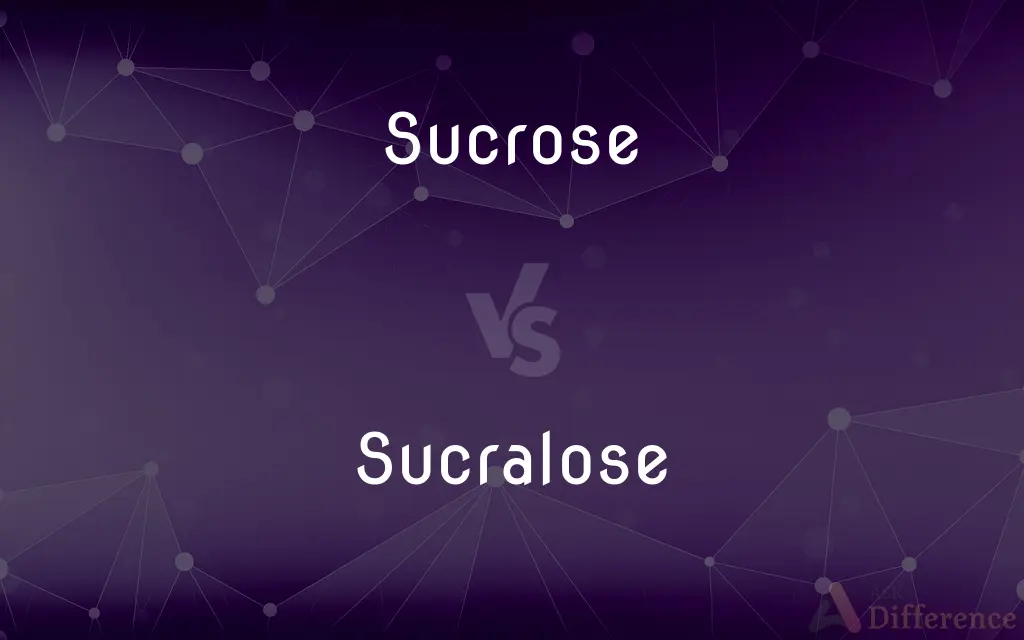Sucrose vs. Sucralose — What's the Difference?
Edited by Tayyaba Rehman — By Fiza Rafique — Updated on April 15, 2024
Sucrose, commonly known as table sugar, is a natural sugar made of glucose and fructose, while sucralose is an artificial sweetener that is about 600 times sweeter and not metabolized by the body.

Difference Between Sucrose and Sucralose
Table of Contents
ADVERTISEMENT
Key Differences
Sucrose is a disaccharide composed of glucose and fructose, naturally found in many plants, especially sugar cane and sugar beets. It is widely used in cooking and baking for its sweetening properties. Sucralose, on the other hand, is a synthetic sweetener derived from sucrose, modified chemically to replace three hydroxyl groups with chlorine atoms, making it much sweeter and not digestible by humans.
The caloric content of sucrose is significant, providing about 4 calories per gram, which contributes to energy but can also lead to weight gain if consumed in excess. Whereas sucralose contains no calories, making it a popular choice for weight management and diabetic diets, as it does not affect blood glucose levels.
Sucrose is metabolized by the body, splitting into glucose and fructose, which are used for energy or stored as fat. Sucralose, in contrast, is not metabolized; it passes through the body without being broken down, thus it does not provide any energy.
In terms of taste, sucrose imparts a natural sweetness that also affects the texture and browning in baked goods. Sucralose, while much sweeter, sometimes imparts a different flavor profile and does not provide the same cooking properties as sucrose, which can affect the outcome in recipes.
Both sweeteners are FDA approved, but they serve different dietary needs and preferences. Sucrose is preferred for its natural sweetness and energy provision, while sucralose is beneficial for those avoiding caloric intake and blood sugar spikes.
ADVERTISEMENT
Comparison Chart
Type
Natural sugar
Artificial sweetener
Caloric Value
4 calories per gram
Zero calories
Sweetness
Natural sweetness
600 times sweeter than sugar
Metabolism
Metabolized as glucose & fructose
Not metabolized by the body
Common Use
General cooking, baking, beverages
Diet foods, diabetic foods
Impact on Baking
Affects texture and browning
Does not brown or affect texture like sugar
Compare with Definitions
Sucrose
It is a disaccharide, consisting of glucose and fructose, broken down by the body into energy.
The sucrose in your morning coffee breaks down to provide a quick energy boost.
Sucralose
Sucralose is an artificial sweetener derived from sucrose, used as a calorie-free sugar substitute.
Sucralose is commonly found in sugar-free chewing gum.
Sucrose
This sugar is involved in browning reactions in baking, known as caramelization.
Sucrose is vital for the caramel flavor and color in caramel sauce.
Sucralose
It is particularly popular among diabetics and those monitoring calorie intake.
Sucralose is a key ingredient in many diabetic-friendly desserts.
Sucrose
Sucrose is table sugar, extracted from sugar cane or sugar beets, used extensively in cooking and baking.
Sucrose is used in making cakes to add sweetness and a golden-brown crust.
Sucralose
It is not recognized by the body as a carbohydrate and is excreted unchanged.
Sucralose passes through the body without contributing calories, making it ideal for low-calorie diets.
Sucrose
Consumed worldwide, sucrose is central to many traditional cuisines and desserts.
Sucrose is a primary ingredient in traditional Indian sweets like jalebi.
Sucralose
Suitable for baking, though it does not caramelize like sucrose.
Sucralose can be used in baking cookies that are sugar-free yet sweet.
Sucrose
Overconsumption of sucrose can lead to health issues like obesity and diabetes.
Reducing sucrose intake is often recommended to manage weight.
Sucralose
Despite its benefits, some people report a slightly different aftertaste compared to sucrose.
Some users find the taste of sucralose less appealing than natural sugar.
Sucrose
Sucrose is made up of one molecule of glucose and one molecule of fructose joined together. It is a disaccharide, a molecule composed of two monosaccharides: glucose and fructose.
Sucralose
Sucralose is an artificial sweetener and sugar substitute. The majority of ingested sucralose is not broken down by the body, so it is noncaloric.
Sucrose
A crystalline disaccharide of fructose and glucose, C12H22O11, extracted chiefly from sugarcane and sugar beets and commonly known as table sugar. Also called saccharose.
Sucralose
An intensely sweet, heat-stable derivative of sucrose that contains no calories.
Sucrose
(carbohydrate) A disaccharide with formula C12H22O11, consisting of two simple sugars, glucose and fructose; normal culinary sugar.
Sucralose
A selectively chlorinated sucrose, used as an artificial sweetener.
Sucrose
A common variety of sugar found in the juices of many plants, as the sugar cane, sorghum, sugar maple, beet root, etc. It is extracted as a sweet, white crystalline substance which is valuable as a food product, and, being antiputrescent, is largely used in the preservation of fruit. Called also saccharose, cane sugar, etc. At one time the term was used by extension, for any one of the class of isomeric substances (as lactose, maltose, etc.) of which sucrose proper is the type; however this usage is now archaic.
Sucrose
A complex carbohydrate found in many plants and used as a sweetening agent
Common Curiosities
Is sucrose bad for your health?
While sucrose is safe in moderation, excessive intake can lead to health problems like obesity and diabetes.
How sweet is sucralose compared to sucrose?
Sucralose is about 600 times sweeter than sucrose.
Can sucralose be used by diabetics?
Yes, sucralose is safe for diabetics as it does not affect blood glucose levels.
What is sucralose?
Sucralose is an artificial sweetener that is made from sucrose and is calorie-free.
How are sucrose and sucralose used in cooking?
Sucrose is used for general cooking and baking, while sucralose is used in low-calorie and diabetic recipes.
Does sucralose provide any energy?
No, sucralose does not provide energy as it is not metabolized by the body.
Can you bake with sucralose just like with sucrose?
You can bake with sucralose, but it will not caramelize or contribute to the texture as sucrose does.
What are the main differences in taste between sucrose and sucralose?
Sucrose has a natural sweetness, while sucralose is much sweeter and some people may notice a different aftertaste.
What is sucrose commonly known as?
Sucrose is commonly known as table sugar.
Can sucralose replace sucrose in all recipes?
Sucralose can replace sucrose in many recipes, especially for sweetness, but it may not provide the same textural properties in baking.
What are the health benefits of using sucralose over sucrose?
Sucralose has the benefit of being calorie-free, making it better for weight management and diabetic diets.
Why is sucrose considered natural and sucralose artificial?
Sucrose is extracted from natural sources like sugar cane and sugar beets, while sucralose is chemically modified in a lab.
Are there any health concerns associated with sucralose?
While approved for consumption, some studies suggest cautious use of any artificial sweeteners, including sucralose.
What is the chemical difference between sucrose and sucralose?
The chemical difference is that sucralose has three chlorine atoms replacing three hydroxyl groups in the sucrose molecule.
How does the body process sucrose and sucralose differently?
The body metabolizes sucrose into glucose and fructose for energy, while sucralose is not metabolized and excreted unchanged.
Share Your Discovery

Previous Comparison
Change vs. Modify
Next Comparison
Component vs. DimensionAuthor Spotlight
Written by
Fiza RafiqueFiza Rafique is a skilled content writer at AskDifference.com, where she meticulously refines and enhances written pieces. Drawing from her vast editorial expertise, Fiza ensures clarity, accuracy, and precision in every article. Passionate about language, she continually seeks to elevate the quality of content for readers worldwide.
Edited by
Tayyaba RehmanTayyaba Rehman is a distinguished writer, currently serving as a primary contributor to askdifference.com. As a researcher in semantics and etymology, Tayyaba's passion for the complexity of languages and their distinctions has found a perfect home on the platform. Tayyaba delves into the intricacies of language, distinguishing between commonly confused words and phrases, thereby providing clarity for readers worldwide.
















































